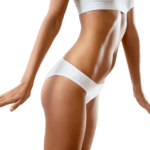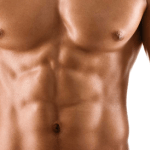Laser Skin Resurfacing in Alpharetta, GA
As we age, certain areas of the facial skin need more than lifts, fillers or BOTOX. Most notably are the wrinkled areas around the mouth and eyes. These areas are especially responsive to laser resurfacing. Laser resurfacing in these areas is often done in conjunction with a facelift and eyelid surgery.
The entire face can be resurfaced to help remove the lines and sun-damaged skin. Fat grafting to add volume is often performed at the same time as resurfacing.
Dr. Graivier is one of the leading experts in laser resurfacing. He has taught numerous courses and lectured to surgeons and dermatologists world-wide on this technology and his personal techniques.
There are several options for patients considering facial laser resurfacing:
• Laser Skin Resurfacing
• Microlaser Peel
• Profractional XC Laser Therapy
Stretch Marks and Scarring
For patients with visible stretch marks, both new and red in color, or older, white lines, or patients with long-standing scars, laser skin resurfacing is also a viable option.
In these areas, the elastic properties of the skin have been over-stretched and cannot come back without help. These areas are treated with the Profractional XC laser that drives micro channels of laser energy into the scars. This leaves normal skin surrounding the micro channels to enhance healing. The micro channels of ablated tissue, in turn, stimulate new collagen and rapid formation, thus improving and tightening areas.
The treatments are done with topical anesthesia. A test area is usually done first to make sure that a full treatment will achieve good results. Treatments may need to be repeated at six week intervals for best results.
Laser Skin Resurfacing Consultation
At The Graivier Center, we value our personal relationships with our patients. Each patient is treated as an individual, and as such, is given a personal consultation prior to any treatment. Dr. Graivier and his staff will meet with you to help you make decisions regarding which procedure(s) or treatment(s) will result in achieving your aesthetic goals. The consultation will conclude with a discussion about the desired treatment, your expectations, the benefits and risks associated with the treatment and post-treatment recovery.
Laser Skin Resurfacing Complementary Procedures
It is a common practice for patients undergoing laser skin resurfacing to combine several procedures at once that will offer complementary or enhanced results. At The Graivier Center, we will take the time to walk potential patients through all of the risks and benefits of each surgery, whether you choose a single treatment or multiple treatments.
Patients undergoing laser skin resurfacing can elect to combine the following procedures for enhanced results:
- Brow lift
- Face lift
- Facial fillers
- Fat grafting
Laser Skin Resurfacing
Cosmetic laser resurfacing is usually done on an outpatient basis and typically takes between 30 minutes and two hours.
Patients with darker skin tones have a greater risk of healing with darker pigmentation (hyperpigmentation). This may be minimized by use of a bleaching agent after laser skin resurfacing.
The Graivier Center offers several different types of laser skin resurfacing:
- Laser Skin Resurfacing
- Microlaser Peel
- Profractional XC Laser Therapy
Laser Skin Resurfacing
Dr. Graivier uses the Erbium YAG Laser (Sciton) to send laser energy to the outer skin surface. This removes the outer layers of skin and stimulates fibroblasts to produce collagen, resulting in smoother, tighter, less wrinkled skin. The entire face can be resurfaced to help remove the lines and sun-damaged skin and replace it with fresh, younger-looking skin. Facial fat grafting to add volume is often performed at the same time as resurfacing.
Acne scarring, pigment changes and larger pores can be treated. This type of laser can also be used on your neck, chest or hands.
Downtime is about one week.
Microlaser Peel
Microlaser peel is a skin freshening peel with less downtime and quicker recovery than resurfacing. The laser peel removes the outer layers of the skin without a large amount of heat being generated. It does not address the deeper wrinkles, but your skin is markedly fresher and rejuvenated. Superficial actinic keratosis and seborrheic keratosis are removed, and the procedure is done with topical anesthesia and oral sedation. The recovery time is between two and three days. It leaves your skin smoother and more radiant.
Profractional XC Laser Therapy
Profractional XC Laser Therapy uses fractionated laser energy to make micro-ablated channels in the skin. Laser channels penetrate into the deeper layers of the skin leaving surrounding tissue intact to promote rapid healing with minimal downtime.
This stimulates production of collagen and elastin, which will thicken and make the skin healthier. This is particularly effective for acne scaring and for stretch marks and other areas of white scars.
It is often combined with micro-laser peels and has a rapid recovery, usually one to three days.
While the effects of laser resurfacing can last for many years, the normal aging process means that wrinkles and expression lines will reoccur. You may repeat laser resurfacing as necessary.
Laser Skin Resurfacing Recovery
Your recovery time will depend on which laser skin-resurfacing treatment you choose. Recovery varies from one day to one week.
Skin that is treated with laser resurfacing may react in different ways. For most patients, it will feel like a mild sunburn, with some redness and swelling. Patients may also experience itching or stinging for a few days after the procedure. Patients are advised to not scratch or pick at the treatment area as this may lead to scarring.
The majority of patients will experience a drying and peeling of the treatment area approximately five days after.
Patients will need to use sunscreen and moisturizer every day. Dr. Graivier will help you select the correct type of sunscreen and moisturizer to best protect your treated areas. All patients will be extra sensitive to sunlight for up to one year. The Graivier Center advises that patients minimize sun exposure and use the suggested sunscreen liberally.
Some patients may experience red or pink skin for several months after the laser skin resurfacing.
When to Consider Laser Skin Resurfacing
- If your facial skin is aged or sun-damaged, with wrinkling around eyes, forehead or mouth
- If you have irregular changes in skin color, such as blotchiness, liver spots or brown spots
- If you have irregular changes in skin color, such as blotchiness, liver spots or brown spots
- If you have scars that have made the surface of your skin uneven, such as acne or chickenpox scars
- If you have certain precancerous skin growths
- If you have enlarged oil glands on the nose

Laser Skin Resurfacing Before and After Results
Laser skin resurfacing offers a powerful solution for patients looking to rejuvenate the appearance of their skin. At The Graivier Center, our laser skin resurfacing before and after gallery highlights the transformative effects of this procedure, particularly for areas around the mouth and eyes where wrinkles and sun damage are most prominent. Dr. Graivier’s expertise in laser skin resurfacing provides patients with smoother, more youthful skin. Whether performed as a standalone treatment or in combination with other treatments like facelifts and eyelid surgery, this treatment can effectively reduce lines, improve texture, and restore a radiant complexion. View our gallery to see the outstanding results that can be achieved with laser skin resurfacing.
Laser Skin Resurfacing Cost in Alpharetta, GA
The laser skin resurfacing cost varies depending on the areas treated, the technique used, and whether additional procedures, such as microlaser peels or Profractional XC laser therapy, are included. During your consultation, Dr. Graivier will assess your skin and discuss the best approach to achieve your desired results. We are committed to providing transparent pricing and will offer a personalized cost estimate based on your unique needs. To make laser skin resurfacing treatments more accessible, we offer flexible financing solutions that can help fit your budget. Contact us today to schedule your consultation and receive a detailed breakdown of the cost.
Serving Alpharetta, GA and Surrounding Areas
The Graivier Center, located in Alpharetta, serves patients across North Atlanta, including Milton (5 miles), Roswell (6 miles), Johns Creek (7 miles), Sandy Springs (10 miles), and Dunwoody (12 miles). Our expert team specializes in laser skin resurfacing and other advanced treatments to help you achieve smoother, more youthful skin. Whether you’re addressing fine lines, scars, or sun damage, Dr. Graivier’s skillful approach will ensure that your treatment is tailored to your needs. Schedule a consultation today to discover how laser skin resurfacing can enhance your skin’s appearance and restore your natural glow.












